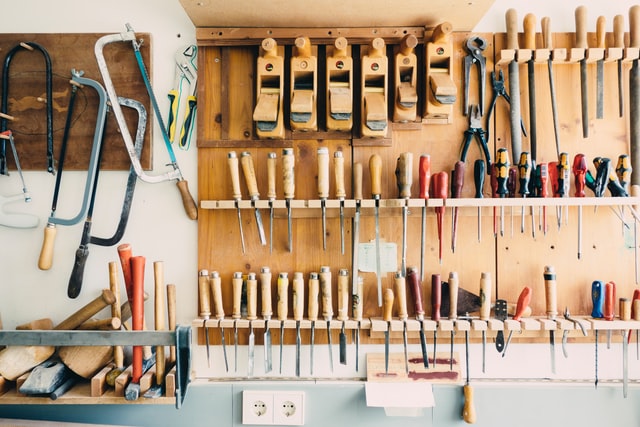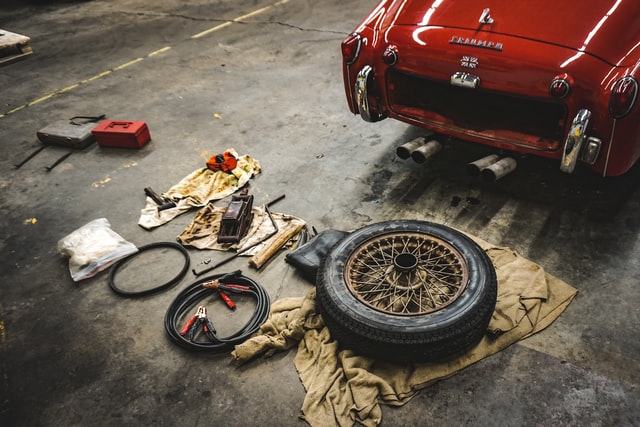Some people only attempt DIY car repairs and maintenance when they have to. On the other hand, some people long to spend their free weekends in the garage, working on souping up their car’s engine or upgrading their vehicle with custom detailing. Many car enthusiasts get bit by the restoration bug. They want to transform their garage into a classic car restoration workshop to indulge in their hobby and perfect their skills. In this guide, we’ll cover some tips for creating the perfect car workshop and beginner’s car maintenance, commonplace DIY car repairs, and budget concerns.
Home Car Repair and Maintenance
According to AAA, “the total cost of owning and operating a vehicle averages more than $8,500 a year.” By performing your own car maintenance and repairs at home, you can reduce your annual car-related costs. As a result, working on cars in your garage isn’t just a great hobby; it has definite financial rewards.
Of course, if you intend to work on classic autos, you can expect to pay somewhat ‘dear’ prices for vintage parts. Still, by performing your own repairs and maintenance on your newer ride, you may have extra money to indulge in your restoration hobby. The more time you spend working on cars at home, the more you can develop and hone your restoration skills. You may even find that family and friends may request and wish to hire you for your services.
Storage
When you’re designing your restoration garage, you’ll want to include plenty of storage features for parts and supplies. It’s tough to stay organized when you don’t have the proper organizational and storage features needed to accommodate your hobby. When outfitting your garage, you’ll want to install some storage features such as:
Shelving System
A shelving system provides you with stowing space for your items, but its open design allows for convenient access to the items when you need them. When considering a shelving system, you may want to include both freestanding shelves and overhead storage units. Although you can build your own, you may be able to find inexpensive but durable shelving units online or at local home improvement stores.
If you shop for automotive storage systems at an automotive store, you can expect to pay more, but you can pay substantially less if you can adapt general storage units to your garage. Be sure that you choose sturdy shelves with plain, durable finishes. You may also want to top your shelves with rubber buckets where you can toss greasy tools or small parts like nuts and bolts so that you can keep your shelves neat and better organized.
Storage for Tools
Automotive tools aren’t cheap, especially if you invest in top-tier brands. Consider investing in specialized storage features for your tools. A rubber bucket is fine temporarily to house greasy tools that you’re using, but when it comes time to clean and stow them, you’ll want to situate them in units such as:
- Cabinets or tool chests
- Boxes (not cardboard which absorbs moisture, use rubber, wood, or some other material that’s suited to a garage space)
- Pegboard storage and hooks
- A slat wall for stowing bigger tools
Consider the tools you already own and those you wish to purchase in the near future when designing storage solutions for your restoration garage. Floor-to-ceiling cabinets and small outdoor sheds built next to your garage may be needed to accommodate your collection of parts and equipment as it grows.
DIY Workbench

A sturdy workbench is a must for your restoration garage. Although much of the work will be performed on the vehicle, you’ll find that many parts need adjusting that can be more comfortably performed at a workbench complemented with strong lighting. You can make your own workbench to suit your style and needs. You can purchase a welded steel base if you choose or create a base from heavy-duty scrap wood. You can also purchase countertop material like granite to place atop your tool chests or existing bench base to create a workstation that is ideally suited for your height and work needs.
Naturally, you can also purchase a ready-made mechanic’s workbench. These are available in many styles and materials. If you intend for your garage to be an auto showplace, you might want to opt for a more traditional workstation to complement the stunning workmanship of your restored vehicles.
DIY Car Maintenance

Once you start working on cars at home, you’ll need to keep a wide range of tools and equipment on hand. Different maintenance tasks require various tools. Generally, you are likely to require the following supplies either now or in the near future as you develop your mechanical prowess:
Essential Car Maintenance Tools
- Screwdrivers (ideally a set with different sizes)
- Wrench set
- Impact wrench
- Flex head ratchet set
- Air ratchet
- Torque wrench
- Wire cutters
- Pliers
- Rubber mallet
- Oil drain pan/oil funnel
- Floor jack and jack stand
- Ramps
- Digital multimeter
- Jumper cables
- OBD Scanner
- Portable work light
- Work gloves
Chemicals
- Grease remover
- Lubricants
- Rust penetrant
These items will provide you with the basics you’ll need to work on autos or even motorcycles. As you grow your hobby, you can add to your repertoire of valuable tools and equipment.
Investing in a Car Hoist
A car hoist is a considerable investment, but it can make life in your garage much easier once you commit to this hobby. You can perform underbody auto work with tremendous ease when you have a car lift in your garage. You’ll need to decide what kind of lift is ideal for your garage setting. You can opt for a two-post lift, which is less expensive than a four-car lift, but it may not provide the support you need for heavier vehicles. While two-post lifts are ideal for temporary repair work, four-post lifts are ideal for storing your vehicle. If you don’t intend to work during the winter months, you can keep your classic car stowed on a four-post lift.
Car Maintenance You Can Perform at Home
You can avoid taking your cars to a mechanic by performing many car maintenance tasks at home. Many of these maintenance tasks require only some working knowledge of auto maintenance and parts. You may be able to perform them easily with the help of a maintenance manual or YouTube videos. Some of the most common home DIY car repairs and maintenance solutions include:
- Repairing leaky valves (leaky valves are rare these days, but they can occur and lead to considerable damage if not quickly repaired)
- Replacing wiper blades (you can save considerably by replacing your own wipers instead of taking them to the dealer or an oil change center).
- Oil changes (you can save roughly $20 with a DIY oil change)
- Replacement of engine air filters (air filters range in price between $10-$70, but labor increases the cost by roughly $70-$120, so it pays to do it yourself)
- Replacing headlights/tail lights (save approximately $20 by performing this task yourself)
- Changing the battery (save up to $50 when you change the battery yourself)
- Changing flat tires (be sure to have a spare tire in your garage for flat tire emergencies)
- Fixing minor dents (try to attempt fixing small dents before trying your hand at larger ones)
- Filling in paint chips/scratches (you can pick up your auto paint color at your dealer and save upwards of $50 by repairing these issues yourself)
- Changing brake pads (if you aren’t sure how to perform this task, try to learn the skill from a friend who does)
- Cleaning the upholstery (you don’t need any particular automotive skill to clean car upholstery. Follow the upholstery cleaner’s instructions)
Classic Car Restoration

Classic car restoration is a labor of love for car enthusiasts. It requires both an investment of time and money. Not only is it a great hobby, but it can lead to the accumulation of terrific auto assets. As you approach this new hobby and ready your garage or outbuilding for the endeavors to come, you’ll want to consider the following:
Setting Up a Budget
Vintage car parts and classic cars, even in inoperable condition, can be pricey. You may want to establish a budget for your hobby. If you intend to restore and later sell the vehicles, you’ll always want to keep an eye on auction prices so that you know what similarly restored vehicles are going for. That way, you won’t wind up investing more in a vehicle than you’ll ever be able to recoup should you decide to sell.
Finding the Perfect Car and Parts
If you love classic cars, you probably already have a favorite. There are many avenues for finding classic cars for your restoration projects. First, you probably want to perform a local search as shipping a car will be pretty costly. Check local ads or search online auction sites for vintage cars for sale near your zip code.
You may also want to join some online forums to find out about classic car sales in your area. These forums can be beneficial moving forward as you can share information or ask for more experienced hobbyist mechanics and auto restoration gurus. Be sure to attend classic car events where you can meet and network with other people who share your love for car restoration.
When it comes to finding vintage auto parts, you may be hard-pressed at times to find what you’re looking for. You may need to adapt parts from other makes or models to suit your classic car. You can typically find many old car parts on online auction sites like eBay, which has a special automotive section.
Space, Tools, and Equipment
You can adapt your current garage space for your classic car restoration hobby. In time, you may wish to upgrade your space with a larger garage. The same tools you used to repair and maintain your newer vehicle can be used to restore a classic auto. If you don’t already know-how, you may want to take a welding class and invest in welding equipment to support your restoration projects. Other helpful restoration tools you may need include:
- Grinder
- Auto jig
- Paint remover
- Air compressor
- Dent puller
Mechanical Considerations
Mechanical considerations always begin with a careful evaluation of the prospective project. Before you invest in a classic car to restore, be sure you understand what you’re getting into. You may be required to rebuild its engine, remove and reapply paint, revamp its electrical components, gut and replace the interior, etc. Assessing the project’s scope will help you determine if it’s in the scope of your budget and how much time the project may require.
If you love cars, creating a DIY mechanic’s garage for custom repairs and restoration projects will provide you with a space for doing what you enjoy. Use this guide to set up your garage and to get started on your new vehicle restoration hobby.




